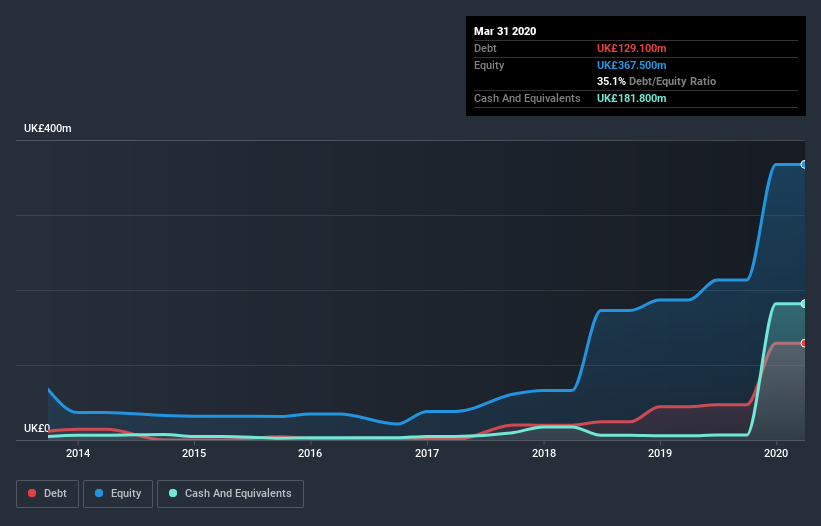Future (LON:FUTR) Has A Rock Solid Balance Sheet

David Iben put it well when he said, 'Volatility is not a risk we care about. What we care about is avoiding the permanent loss of capital.' When we think about how risky a company is, we always like to look at its use of debt, since debt overload can lead to ruin. As with many other companies Future plc (LON:FUTR) makes use of debt. But the real question is whether this debt is making the company risky.
Why Does Debt Bring Risk?
Debt and other liabilities become risky for a business when it cannot easily fulfill those obligations, either with free cash flow or by raising capital at an attractive price. In the worst case scenario, a company can go bankrupt if it cannot pay its creditors. However, a more usual (but still expensive) situation is where a company must dilute shareholders at a cheap share price simply to get debt under control. Of course, the upside of debt is that it often represents cheap capital, especially when it replaces dilution in a company with the ability to reinvest at high rates of return. The first thing to do when considering how much debt a business uses is to look at its cash and debt together.
See our latest analysis for Future
What Is Future's Debt?
You can click the graphic below for the historical numbers, but it shows that as of March 2020 Future had UK£129.1m of debt, an increase on UK£44.5m, over one year. But it also has UK£181.8m in cash to offset that, meaning it has UK£52.7m net cash.
How Healthy Is Future's Balance Sheet?
Zooming in on the latest balance sheet data, we can see that Future had liabilities of UK£78.5m due within 12 months and liabilities of UK£146.8m due beyond that. On the other hand, it had cash of UK£181.8m and UK£50.0m worth of receivables due within a year. So it can boast UK£6.50m more liquid assets than total liabilities.
Having regard to Future's size, it seems that its liquid assets are well balanced with its total liabilities. So while it's hard to imagine that the UK£1.36b company is struggling for cash, we still think it's worth monitoring its balance sheet. Succinctly put, Future boasts net cash, so it's fair to say it does not have a heavy debt load!
Better yet, Future grew its EBIT by 161% last year, which is an impressive improvement. If maintained that growth will make the debt even more manageable in the years ahead. When analysing debt levels, the balance sheet is the obvious place to start. But it is future earnings, more than anything, that will determine Future's ability to maintain a healthy balance sheet going forward. So if you're focused on the future you can check out this free report showing analyst profit forecasts.
Finally, while the tax-man may adore accounting profits, lenders only accept cold hard cash. Future may have net cash on the balance sheet, but it is still interesting to look at how well the business converts its earnings before interest and tax (EBIT) to free cash flow, because that will influence both its need for, and its capacity to manage debt. Over the last three years, Future actually produced more free cash flow than EBIT. That sort of strong cash generation warms our hearts like a puppy in a bumblebee suit.
Summing up
While we empathize with investors who find debt concerning, you should keep in mind that Future has net cash of UK£52.7m, as well as more liquid assets than liabilities. And it impressed us with free cash flow of UK£52m, being 125% of its EBIT. So is Future's debt a risk? It doesn't seem so to us. The balance sheet is clearly the area to focus on when you are analysing debt. But ultimately, every company can contain risks that exist outside of the balance sheet. Take risks, for example - Future has 3 warning signs we think you should be aware of.
When all is said and done, sometimes its easier to focus on companies that don't even need debt. Readers can access a list of growth stocks with zero net debt 100% free, right now.
This article by Simply Wall St is general in nature. It does not constitute a recommendation to buy or sell any stock, and does not take account of your objectives, or your financial situation. We aim to bring you long-term focused analysis driven by fundamental data. Note that our analysis may not factor in the latest price-sensitive company announcements or qualitative material. Simply Wall St has no position in any stocks mentioned.
Have feedback on this article? Concerned about the content? Get in touch with us directly. Alternatively, email editorial-team@simplywallst.com.


